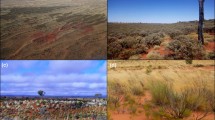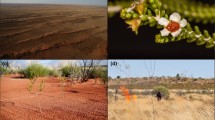Abstract
Two ecological models have been put forward to explain the dynamics of fire-promoting and fire-sensitive vegetation in southwest Tasmania: the alternative stable states model of Jackson (in Proc Ecol Soc Aust 3:9–16, 1968) and the sharpening switch model of Mount (in Search 10:180–186, 1979). Assessing the efficacy of these models requires high resolution spatio-temporal data on whether vegetation patterns are stable or dynamic across landscapes. We analysed ortho-rectified sequences of aerial photography and satellite imagery from 1948, 1988 and 2010 to detect decadal scale changes in forest and non-forest vegetation cover in southwest Tasmania. There was negligible change from forest to non-forest (<0.05%) and only a modest change from non-forest to forest over the study period. Forest cover increased by 4.1% between 1948 and 1988, apparently due to the recovery of forest vegetation following stand-replacing fire prior to 1948. Forest cover increased by 0.8% between 1988 and 2010, reflecting the limited ability of forest to invade treeless areas. The two models include interactions between vegetation, fire and soil, which we investigated by analysing the chemical (phosphorus, nitrogen) and physical properties (clay, silt) of 128 soil samples collected across 34 forest–non-forest boundaries. Phosphorus in the upper horizon was typically lower in non-forest vegetation compared to forest vegetation, which is consistent with proposed fire–vegetation–soil feedbacks. Mineral horizons were dominated by sand, with low levels of clay under all vegetation types. Available field evidence lends support to the Jackson (1968) alternative stable states model as the most suitable model of vegetation dynamics on nutrient poor substrates in southwest Tasmania although modifications of the timeframes for transitions toward rainforest are required.







Similar content being viewed by others
References
Balmer J (1990) Two moorland boundaries. Tasforests 2:133–141
Banfai DS, Brook BW, Bowman DMJS (2007) Multiscale modelling of the drivers of rainforest boundary dynamics in Kakadu National Park, northern Australia. Divers Distrib 13:680–691
Bates D, Maechler M, Dai B (2008) lme4: linear mixed-effects models using s4 classes. http://cran.r-project.org. Verified March 2011
Beisner BE, Haydon DT, Cuddington K (2003) Alternative stable states in ecology. Front Ecol Environ 1:376–382
Bond WJ (2010) Do nutrient-poor soils inhibit development of forests? A nutrient stock analysis. Plant Soil 334:47–60
Bond WJ, Woodward FI, Midgley GF (2005) The global distribution of ecosystems in a world without fire. New Phytol 165:525–537
Bowman DMJS (2000) Australian rainforests: islands of green in an ocean of fire. Cambridge University Press, Cambridge
Bowman DMJS, Jackson WD (1981) Vegetation succession in southwest Tasmania. Search 12:358–362
Bowman DMJS, Wood SW (2009) Fire driven land cover change in Australia and W.D. Jackson’s theory of the fire ecology of southwest Tasmania. In: Cochrane MA (ed) Fire and tropical ecosystems. Springer, New York, pp 87–106
Bowman DMJS, Maclean AR, Crowden RK (1986) Vegetation-soil relations in the lowlands of south-west Tasmania. Aust J Ecol 11:141–153
Bowman DMJS, Murphy BP, Banfai DS (2010) Has global environmental change caused monsoon rainforests to expand in the Australian monsoon tropics? Landscape Ecol 25:1247–1260
Brook BW, Bowman DMJS (2006) Postcards from the past: charting the landscape-scale conversion of tropical Australian savanna to closed forest during the 20th century. Landscape Ecol 21:1253–1266
Brown MJ, Podger FD (1982) Floristics and fire regimes of a vegetation sequence from sedgeland-heath to rainforest at Bathurst Harbor, Tasmania. Aust J Bot 30:659–676
Brown MJ, Balmer J, Podger FD (2002) Vegetation change over 20 years at Bathurst Harbour, Tasmania. Aust J Bot 50:499–510
Burnham KP, Anderson DR (2002) Model selection and multimodel inference: a practical information-theoretic approach. Springer-Verlag, New York
Colhoun EA (1996) Application of Iversen’s glacial-interglacial cycle to interpretation of the late last glacial and Holocene vegetation history of western Tasmania. Quat Sci Rev 15:557–580
Cressie NAC (1993) Statistics for spatial data. Wiley, New York
di Folco M-B (2007) Tasmanian organic soils. Dissertation, University of Tasmania
di Folco M-B, Kirkpatrick JB (2011) Topographic variation in burning-induced loss of carbon from organic soils in Tasmanian moorlands. Catena 87:216–225
Fensham RJ, Fairfax RJ (2002) Aerial photography for assessing vegetation change: a review of applications and the relevance of findings for Australian vegetation history. Aust J Bot 50:415–429
Fletcher MS, Thomas I (2007) Holocene vegetation and climate change from near Lake Pedder, south-west Tasmania, Australia. J Biogeogr 34:665–677
Fletcher MS, Thomas I (2010) The origin and temporal development of an ancient cultural landscape. J Biogeogr 37:2183–2196
Geldenhuys CJ (1994) Bergwind fires and the location pattern of forest patches in the southern Cape landscape, South-Africa. J Biogeogr 21:49–62
Gentilli J (1972) Australian climate patterns. The Griffin Press, Canberra
Grose MR, Barnes-Keoghan I, Corney SP, White CJ, Holz GK, Bennett JB, Gaynor SM, Bindoff NL (2010) Climate futures for Tasmania: general climate impacts technical report. Antarctic Climate and Ecosystems Cooperative Research Centre, Hobart
Harris S, Kitchener A (2005) From forest to fjaeldmark: descriptions of Tasmania’s vegetation. Department of Primary Industries, Water and Environment, Hobart
Henderson W, Wilkins CW (1975) The interaction of bushfires and vegetation. Search 6:130–133
Hobbs RJ, Suding KN (2008) New models for ecosystem dynamics and restoration ecology. Island Press, Washington, DC
Hoffmann WA, Adasme R, Haridasan M, de Carvalho MT, Geiger EL, Pereira MA, Gotsch SG, Franco AC (2009) Tree topkill, not mortality, governs the dynamics of savanna-forest boundaries under frequent fire in central Brazil. Ecology 90:1326–1337
Isbell RF (2002) The Australian soil classification. CSIRO Publishing, Melbourne
Jackson WD (1968) Fire, air, water and earth—an elemental ecology of Tasmania. Proc Ecol Soc Aust 3:9–16
Jackson WD (2000) Nutrient stocks in Tasmanian vegetation and approximate losses due to fire. Pap Proc R Soc Tasman 134:1–17
King KJ, Cary GJ, Bradstock RA, Chapman J, Pyrke A, Marsden-Smedley JB (2006) Simulation of prescribed burning strategies in south-west Tasmania, Australia: effects on unplanned fires, fire regimes, and ecological management values. Int J Wildland Fire 15:527–540
Kuo S (1996) Phosphorus. In: Sparks DL (ed) Methods of soil analysis part 3: chemical methods. Soil Science Society of America, Madison, pp 869–919
Latham RE (2003) Shrubland longevity and rare plant species in the northeastern United States. For Ecol Manag 185:21–39
Lehmann CER, Archibald SA, Hoffmann WA, Bond WJ (2011) Deciphering the distribution of the savanna biome. New Phytol 191:197–209
Lindenmayer DB, Hobbs RJ, Likens GE, Krebs CJ, Banks SC (2011) Newly discovered landscape traps produce regime shifts in wet forests. Proc Natl Acad Sci USA 20:15887–15891
Lucas C, Hennessy K, Mills G, Bathols J (2007) Bushfire weather in Southeast Australia: recent trends and projected climate change impacts. Bushfire Cooperative Research Centre, Melbourne
Macphail MK (1979) Vegetation and climates in southern Tasmania since the Last Glaciation. Quat Res 11:306–341
Macphail MK, Pemberton M, Jacobson G (1999) Peat mounds of southwest Tasmania: possible origins. Aust J Earth Sci 46:667–677
Maranon T, Bartolome JW (1993) Reciprocal transplants of herbaceous communities between Quercus agrifolia woodland and adjacent grassland. J Ecol 81:673–682
Marsden-Smedley JB (1998) Changes in southwestern Tasmanian fire regimes since the early 1800s. Pap Proc R Soc Tasman 132:15–29
Marsden-Smedley JB, Kirkpatrick JB (2000) Fire management in Tasmania’s wilderness world heritage area: ecosystem restoration using indigenous-style fire regimes? Ecol Manag Restor 1:195–203
Mount AB (1979) Natural regeneration processes in Tasmanian forests. Search 10:180–186
Murphy BP, Paron P, Prior LD, Boggs GS, Franklin DC, Bowman DMJS (2010) Using generalized autoregressive error models to understand fire-vegetation-soil feedbacks in a mulga-spinifex landscape mosaic. J Biogeogr 37:2169–2182
Mutch RW (1970) Wildland fires and ecosystems—a hypothesis. Ecology 51:1046–1051
Nicholas AMM, Franklin DC, Bowman DMJS (2011) Floristic uniformity across abrupt boundaries between Triodia hummock grassland and Acacia shrubland on an Australian desert sandplain. J Arid Environ 75:1090–1096
Odion DC, Moritz MA, DellaSala DA (2010) Alternative community states maintained by fire in the Klamath Mountains, USA. J Ecol 98:96–105
Peltzer DA (2001) Plant responses to competition and soil origin across a prairie-forest boundary. J Ecol 89:176–185
Pemberton M (1989) Southwest Tasmania. Land systems of Tasmania. Department of Agriculture, Hobart
Perry GLW, Enright NJ (2002) Humans, fire and landscape pattern: understanding a maquis-forest complex, Mont Do, New Caledonia, using a spatial ‘state-and-transition’ model. J Biogeogr 29:1143–1158
Petraitis PS, Latham RE (1999) The importance of scale in testing the origins of alternative community states. Ecology 80:429–442
Podger FD, Bird T, Brown MJ (1988) Human activity, fire and change in the fores at Hogsback Plain, southern Tasmania. In: Frawley KJ, Semple NM (eds) Australia’s ever changing forests. Department of Geography and Oceanography and Australian Defence Force Academy, Canberra, pp 119–140
Read J (2001) Soil and rainforest composition in Tasmania: correlations of soil characteristics with canopy composition and growth rates in Nothofagus cunninghamii associations. Aust J Bot 49:121–135
Richards SA (2005) Testing ecological theory using the information-theoretic approach: examples and cautionary results. Ecology 86:2805–2814
Sanders G (2010) An historical analysis of grassland/moorland and forest boundaries at Surrey Hills, Tasmania. Dissertation, University of Tasmania
Scheffer M, Carpenter S, Foley JA, Folke C, Walker B (2001) Catastrophic shifts in ecosystems. Nature 413:591–596
Schroder A, Persson L, De Roos AM (2005) Direct experimental evidence for alternative stable states: a review. Oikos 110:3–19
Staver AC, Archibald S, Levin S (2011) Tree cover in sub-Saharan Africa: rainfall and fire constrain forest and savanna as alternative stable states. Ecology 92:1063–1072
Thomas I, Cullen P, Fletcher MS (2010) Ecological drift or stable fire cycles in Tasmania: a resolution? In: Haberle SG, Stevenson J, Prebble M (eds) Altered ecologies: fire, climate and human influence on terrestrial landscapes. ANU E Press, Canberra, pp 341–352
Tng DYP, Sanders G, Murphy BP, Williamson GJ, Kemp J, Bowman DMJS (2010) Rainforest expansion in far north Queensland: a preliminary analysis of the Windsor and Carbine Tablelands. Marine and Tropical Sciences Research Facility (MTSRF) transition project final report. Reef and Rainforest Research Centre Limited, Cairns
Warman L, Moles AT (2009) Alternative stable states in Australia’s Wet Topics: a theoretical framework for the field data and a field-case for the theory. Landscape Ecol 24:1–13
Wilson JB, Agnew ADQ (1992) Positive-feedback switches in plant communities. Academic Press, London
Wood SW, Murphy BP, Bowman DMJS (2011a) Firescape ecology: how topography determines the contrasting distribution of fire and rain forest in the south west of the Tasmanian Wilderness World Heritage Area. J Biogeogr 38:1807–1820
Wood SW, Hua Q, Bowman DMJS (2011b) Fire-patterned vegetation and the development of organic soils in the lowland vegetation mosaics of south-west Tasmania. Aust J Bot 59:126–136
Acknowledgments
This work was supported by an Australian Research Council Discovery Grant (award no. DP0878177), a Holsworth Wildlife Research Endowment (award no. B0017510) and a Planet Action Imagery Grant (project ID: 7528). We thank David Wilson for producing the ortho-rectified photo mosaics; Scott Browning, Laura Reid and Mike Perring for assistance with the field program; and Brett Murphy and Lynda Prior for statistical advice. We thank Jon Marsden-Smedley for use of his fire maps. Phosphorus analysis was conducted at the Ecosystems Research Laboratory at the University of Western Australia.
Author information
Authors and Affiliations
Corresponding author
Electronic supplementary material
Below is the link to the electronic supplementary material.
Rights and permissions
About this article
Cite this article
Wood, S.W., Bowman, D.M.J.S. Alternative stable states and the role of fire–vegetation–soil feedbacks in the temperate wilderness of southwest Tasmania. Landscape Ecol 27, 13–28 (2012). https://doi.org/10.1007/s10980-011-9677-0
Received:
Accepted:
Published:
Issue Date:
DOI: https://doi.org/10.1007/s10980-011-9677-0




